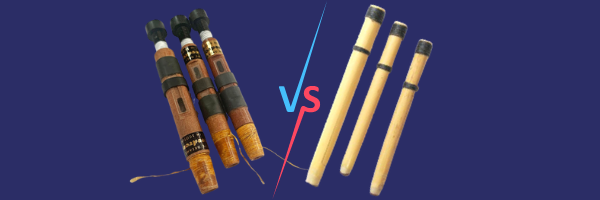Are Some Drone Reeds Less Efficient Than Others?

Have you changed drone reeds and found one set takes more air? Is it the drone reed or are there other factors? How can we test our drone reeds?
Andrew demonstrates the suction test that he uses to check his drone reeds when they are acting poorly.
Listen to This As a Podcast
Click here now to listen to this as a podcast.
Find the Piper’s Dojo Audio Experience podcast on Apple iTunes, SoundCloud, Spotify, Google Podcasts -- or wherever you listen to your podcasts.
Video Transcription:
Andrew:
Why is it that two different sets of drone reeds be set to take the same amount of air, but one set feels like it's taking more air than the other? I like him here, because he's like, "Just by the way, I've been setting it to just past the sweet spot." I like that. It's not that he doesn't understand calibration, at least conceptually. "Can different drone reeds be more or less air efficient when set exactly at the same sweet spot calibration setting?"
Carl:
I think the answer is yes. I think there are some drone reeds that are less efficient, even when perfectly calibrated, due to their design. I don't know. I would also double-check. I know you say they're calibrated just past the sweet spot. Make sure they're not too far past, double and triple-check that. I don't know. From a technical standpoint, if it has a bigger tongue with a bigger hole in it, you can still set the strength, but every time that tongue opens, there's a bigger hole for more air to go through. It might be worth experimenting more with that. Yeah, I think it is possible.
Andrew:
I got one. I like to suck on my drones. Sorry, I tried to make that a shock-rocker kind of response. I like to suck on my drones, I'll show you what I mean in just a second, to test for this. Especially when you play cane, this could be a big issue. I take my drone like this and I turn it around. By the way, don't do this in public, come on. We can put some suction on there, but what I do is very gently, did you hear what I said, very gently, stop the tongue with my finger like this so that no air is coming through and that it'll stop. Then, I suck on the end of the thing. We should get a nice amount of suction going through the reed in reverse.
Andrew:
This isn't perfect, I'm sure there's air sneaking around, but I do, I get a nice amount of suction there. I know that the reed itself and/or the reed seat is not leaking a whole bunch of air. What you'll find, especially with cane drone reeds, is sometimes the wax seal at the bottom is leaking. You'll find this with synthetic reeds, too. A Ezeedrone with a loose screw, if the screw is loose in the nose cone, it's going to leak a whole bunch of air, so I like to do that little suction test.
Andrew:
Then, for Wallace, I wonder if you did that, if you would find that different sets of reeds had more or less satisfactory suction on the back end, but every now and then, I will do that. You're right, it's like I've done all my five steps that we were talking about earlier, right? I know my chanter's not too hard. I've thoroughly done the four questions a couple of times and, man, I'm still struggling for air. Then, every now and then, I'll do that with my drone. I'll take this out and see if I can get ... It's not going to be perfect, because some air is always going to leak around the tongue anyway. You can hear how it gets that little ...
Carl:
The pop, yeah.
Andrew:
If you can get it to make that sound, that's usually a good sign that the rest of the reed is set up. That's just sort of a common sense little trick that I sometimes do. Be gentle, though. Make sure your hands are clean and not disgusting whenever you touch the tongue, because you don't want to get dirt and grime on your tongue, right? Use a lot of common sense in that process, but reverse suction test.
Try a Dojo U Premium Membership for $1
Enjoying this content and want to try Dojo U? Try our Premium Membership for a full month for just one dollar by clicking here now!







Responses